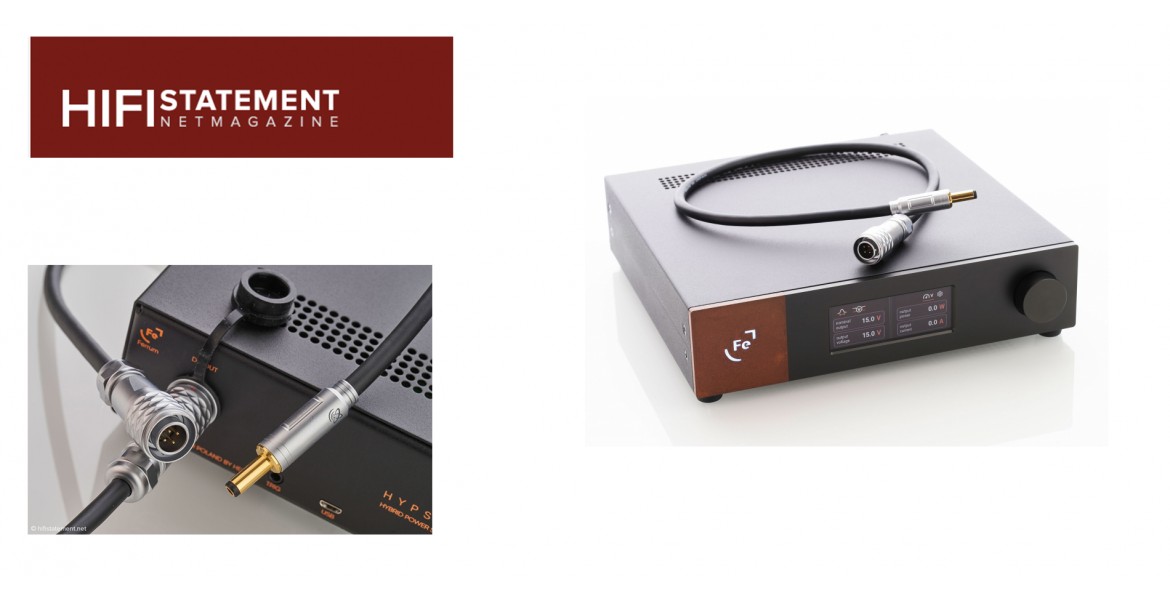
I've been looking forward to this test for over a year. During the development of the HYPSOS hybrid power supply, the first-ever Ferrum product, I was in constant contact with the developers.
I was able to test an HYPSOS with beta firmware back in September. However, the impressive listening experience didn't make the wait any easier.
So, just before the turn of the year, the time has finally come.
The Hifistatement editorial team received two copies of the new Ferrum HYPSOS.
I am very pleased that one of the two hybrid power supplies has landed with me.
After the first impression on the last development meters, I simply didn't want to miss out on a test.
A second power supply unit was delivered to Dirk Sommer. In this article you will read both his and my verdict on the HYPSOS.
It's no secret that Dirk's stereo system puts mine in the shade by a long way.
But that's precisely why it's interesting to examine the PSU in two completely different set ups and on devices in different price categories.
We also arranged a Skype interview with Marcin Hamerla, CEO of HEM and founder of Ferrum.Marcin Hamerla and his team at HEM are not unknown in the hi-fi scene.
The company based near Warsaw is the manufacturer of Mytek.
The Mytek's converters are very much appreciated by the editorial staff.
For example, a Mytek Brooklyn DAC + is permanently playing in my chain. A Brooklyn Bridge, a Brooklyn AMP, and a Liberty DAC were also on test.
A Manhattan DAC II plays in Dirk Sommer's living room chain. By producing Mytek devices, HEM has accumulated a wealth of experience that is not limited to converters.
As a result, the creation of Ferrum was only a matter of time. HEM's new, proprietary product line offers room for innovation and fresh ideas.
The first of its kind is Ferrum's HYPSOS hybrid power supply. It is supposed to combine the best features of a switching power supply and a linear power supply. It is an ambitious goal.
After all, a purely linear power supply is the optimum for hi-fi enthusiasts, at least so far.
Whether this will change from now on, you can find out in this article.
Variable output voltages of five to 30 volts at up to six amps or 60 watts speak for themselves.
But how exactly switching and linear power supply come together in the HYPSOS and what other special functions it offers, we will let Marcin and the head of the development department explain in an interview later.
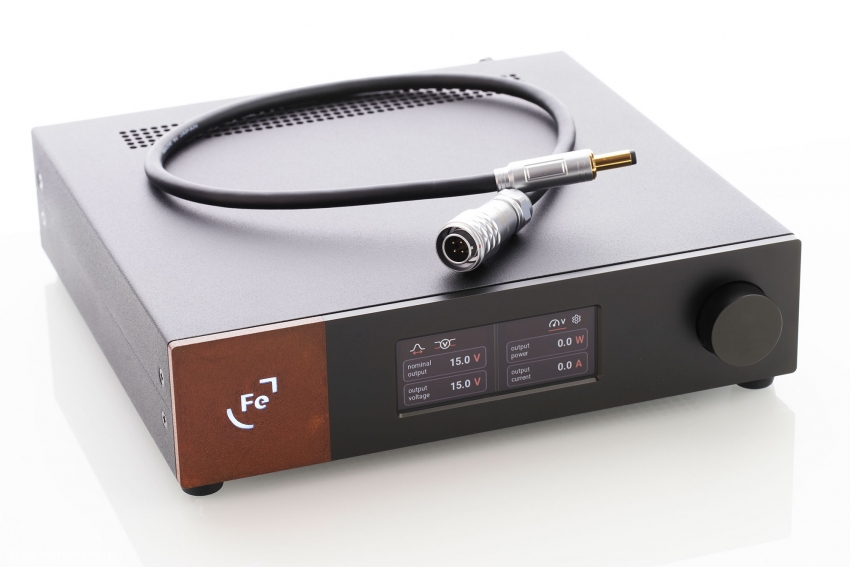
The HYPSOS scores with a simple and straightforward design and has a clear product identity thanks to the logo and iron plate Ferrum, the eponymous element iron is not only found in the product logo, which contains the element abbreviation for iron from the periodic table, but also on the front of the power supply unit.
The backlit logo is framed by a rust-red iron plate and unmistakably marks the HYPSOS as a Ferrum product. Marcin Hamerla's father worked as an ironsmith.
Moreover, the Polish composer and piano virtuoso Chopin was born not far from Warsaw in the small village of Żelazowa Wola. Żelazo means iron in Polish.
The name Ferrum was therefore very obvious. It simultaneously transports a personal memory and a reference to an outstanding composer, thus to musicality itself.
With the logo and iron element on the front, the power supply is a real design piece and not just a block that one would prefer to hide behind the rack.
With its dimensions of around 22 by 20 by 5 centimeters, it has an identical footprint to my Brooklyn DAC +. Therefore, this invites you to place both devices on top of each other. In terms of temperature, this should not be a problem.
I did not notice any disturbing interference in the converter.
The front also has a centrally placed display and a rotary encoder on the right-hand side.
On the back, there is the power connection, a USB socket for firmware updates, and a 3.5-millimeter jack as a trigger input. In addition to a quick start guide, the scope of delivery includes a power cord and two DC cables for connecting the power supply unit to components: one with a 2.5-millimeter plug and a second with a 2.1-millimeter plug.
Both cables are a good 50 centimeters long and other configurations are available upon request.
The cables stood out as unusual in a positive sense.
You do not expect the usual thin DC cable with cold-pressed plugs, but a rather thick cable with four wires and a solid, self-locking plug for connection to the power supply unit itself.
The connection cables perfectly round off the extremely high-quality haptic and optical overall impression of the HYPSOS. 5-millimeter plug and a second with a 2.1-millimeter plug.
Both cables are a good 50 centimeters long and other configurations are available upon request.
The cables stood out as unusual in a positive sense.
You do not expect the usual thin DC cable with cold-pressed plugs, but a rather thick cable with four wires and a solid, self-locking plug for connection to the power supply unit itself.
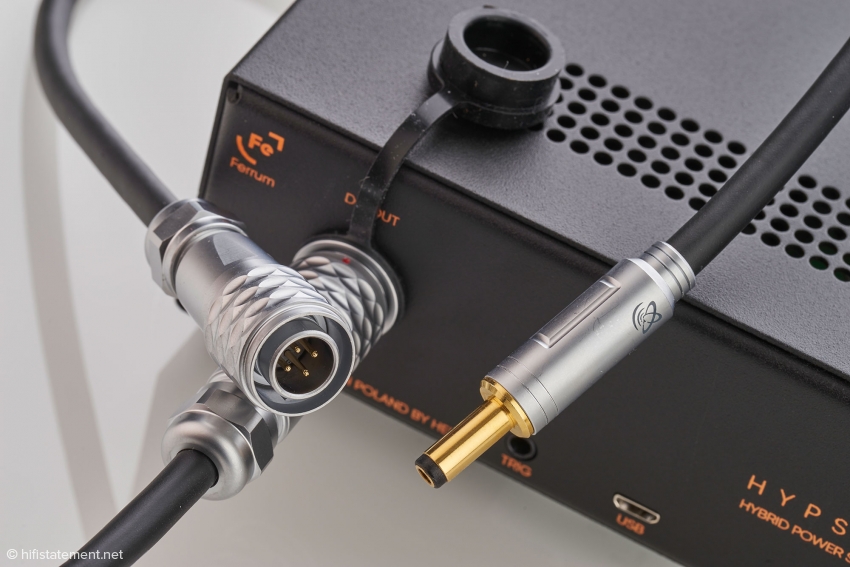
The connection cables perfectly round off the extremely high-quality haptic and optical overall impression of the HYPSOS. 5-millimeter plug and a second with a 2.1-millimeter plug.
Both cables are a good 50 centimeters long and other configurations are available upon request.
The cables stood out as unusual in a positive sense.
You do not expect the usual thin DC cable with cold-pressed plugs, but a rather thick cable with four wires and a solid, self-locking plug for connection to the power supply unit itself.
The connection cables perfectly round off the extremely high-quality haptic and optical overall impression of the HYPSOS. self-locking plug for connection to the power supply unit itself.
The connection cables perfectly round off the extremely high-quality haptic and optical overall impression of the HYPSOS.
self-locking plug for connection to the power supply unit itself.
The connection cables perfectly round off the extremely high-quality haptic and optical overall impression of the HYPSOS.
The connection cables are manufactured to a very high standard and make a powerful impressionWhen switching on the power supply for the first time, the desired voltage and polarity must be selected.
For many units, the correct settings are already stored. All currently pre-configured device profiles can be found at the end of the article after the manufacturer's specifications.
The list can be continuously extended by the Ferrum team by means of firmware updates.
So please feel free to inform the team about your device request.
Of course, you can also configure the HYPSOS manually if your device is not in the list.
All you have to do is determine and set the required voltage and polarity. This information can usually be found on the back of the device or in the manual.
If you are unsure, the manufacturer of your device or Ferrum will certainly help.
One should not forget that an incorrect setting could destroy the device. That's why HYPSOS asks for each setting again and even offers a ten-second time window before the voltage is released, so that you can cancel the process if necessary. A profile is already stored for my Brooklyn DAC +, which I select by pressing the rotary encoder.
The stored voltage and polarity are shown to me for confirmation.
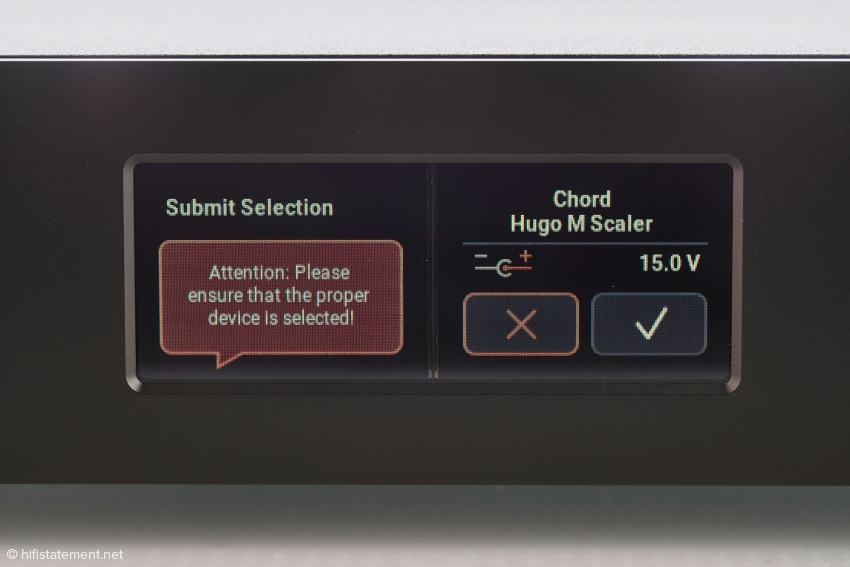
Only then does the HYPSOS release the voltage.Before the voltage is released, the HYPSOS runs through this safety query In the Skype interview, Marcin Hamerla was joined by Paweł Gorgoń, the head of the research and development department at HEM.
Both answered a few questions about the creation of Ferrum and the HYPSOS.
My questions about the technical details, on the other hand, were answered in advance by developer Maksymilian Matuszak via email.
Hifistatement: How did the idea to launch your own brand with Ferrum come about?
Marcin: HEM has been around for about 22 years now and we have about 25 people working for us. We have always worked with Mytek, but we also manufacture many OEM products for industrial audio applications. I am very lucky to have met many good and talented people on my way with HEM.
Paweł, for example, originally begged me to hire him. It has since been reversed and I would beg him to work for me. He joined the company as a student and has proven to be very talented. He is now the head of the research and development department at HEM and our R&D brain. He is great with electronics, a good programmer, and very good at organizing employees.
Paweł: I would like to interject that the best thing about HEM is teamwork. I can't do everything on my own, so I'm happy to have a talented team of electronics specialists and programmers. Without them, the HYPSOS would not have been possible.
Marcin: A few years ago, the engineering team grew. Most of them are very young and audio enthusiasts. Sometimes they are real show-offs, hungry for success, and often unconventional. With a traditional brand like Mytek, there is not always room for this.
That is why Ferrum is like a playground for my engineers and as a result, the HYPSOS was created.
The idea for Ferrum is around two years old.
The intensive brand development began a year ago. However, the development process of the HYPSOS only took about half a year.
That has a lot to do with the high standard of the organization at HEM. The team and its communication and planning are very effective.
This aspect is many times underestimated. It often represented the core difficulty of product development.
The idea of the brand name Ferrum has different origins. One of them lies in the time of the Teuton tribes.
The Vandals lived in what is now Poland at that time.
There was a Vandal iron mine near my house. Even today you still need a permit to dig in the neighborhood, as relics from that time can be found everywhere.
That's why there is an archaeological museum very close by, which we supported.
This is one of the reasons for the name Ferrum.

The HEM and Ferrum research and development team proudly presents HYPSOS, their first baby (from left to right) Arkadiusz Bochyński, Jarosław Jabłoński, Maksymilian Matuszak, Andrzej Dziwiński and Piotr Głudkowski, seated Marcin Hamerla and Paweł Gorgoń)
Hifistatement: Were all HEM employees involved in the development of the HYPSOS or is there a core team?
Marcin: The development department, consisting of seven people, is of course largely responsible for HYPSOS.
As I said, Paweł is the development manager and Max developed most of the entire HYPSOS hardware.
He's also a good programmer but prefers to work with metal. Nevertheless, Ferrum would be impossible without the production, sales, and distribution departments. Every department and every employee is important.
Pawel: Max is surprisingly young in his early twenties but is an outstanding engineer. Marcin: That's right. Family tradition. Even his father is a good engineer, and his son is even better.
Hifistatement: Is there a function or a characteristic of the HYPSOS that you are particularly proud of?
Pawel: I am simply very satisfied with the overall product.
Marcin:For me, the most important thing is the solid basic construction of the power supply.
A special feature of the HYPSOS is the use of a lot of software compared to commercially available power supplies.
Many parameters can be influenced in this way.
Due to the solid basic construction, we were finally able to use software to exceed the originally intended output power.
The finished HYPSOS delivers a continuous output of 80 watts instead of the planned 60 watts.
The pulse power is even 200 watts. We still have to adjust the technical data on our website. (Editor's note: In the manufacturer's information, we accordingly state the value previously stated on the website). When I asked my final question about the future of Ferrum and new products, Marcin kept a low profile.
There are many ideas and a good team on top of that. So I would be very surprised if the HYPSOS was the last Ferrum product.
Now for the technical details that Max explained via email.
Hifistatement: The HYPSOS combines the technology of a switched-mode power supply with that of a linear power supply. How do these two types work together in HYPSOS and what are the advantages of a hybrid power supply unit?
Max:We decided on a hybrid design for the HYPSOS because we wanted to keep the residual ripple and noise at the output low, but still wanted to have a large output voltage range.
A linear regulator is the best to keep the noise down, but with the HYPSOS output voltage range the heat sink would be the size of the moon so we had to find another way.
That's why we decided to keep the linear regulator but put an efficient stage with a switching regulator in front of our discrete low-drop-out voltage regulator (LDO), which keeps the voltage at the LDO constant and minimizes power dissipation.
This allowed us to keep the power loss low, but the residual ripple at the output is greatly reduced because we are still using a linear regulator.
As I said, it suppresses the residual ripple. Besides, we use a two-stage LC filter after the switching converter to further suppress the noise to smooth the voltage at the output of the regulator.
All in all, we have succeeded in developing a power supply unit that has a lower power loss than a linear regulator.
But we still have a fast transient response in switching current, low noise, and low ripple, as is the case with the linear regulator. This wouldn't be possible if we were just using a switching regulator.
Hifistatement: 4T Sensing Design and Spread Spectrum Mode are two special functions of the power supply.
Please briefly explain to our readers how they work and the resulting effect on audio reproduction. Max:4 Terminal Sensing Design (4TSD) is a feature that greatly reduces the influence of the cable resistance on the voltage at the output of the cable.
Most external power supplies measure their output voltage directly at their output, but not at the load, at the end of the cable.
Therefore, the current supplied by the power supply is what causes the voltage drop across resistance of the cable. So, if the current supplied by the power supply is high, the voltage seen by the load may be lower than the voltage at the output of the power supply.
For this reason, the HYPSOS is equipped with 4TSD, which measures the voltage directly at the output of the cable and not at the output of the power supply, so that the effect of the voltage drop on the cable is minimized.
We use a 4-wire cable, with two wires for the power supply and the other two wires for voltage measurement. In this way, the high current only flows through the two wires that are intended for the power supply.
Almost no current flows in the cores that are intended for voltage measurement so that there is no voltage drop in these measuring cables and the influence of the cable resistance is reduced to a minimum. This is very important as changing the supply current has much less impact on the output voltage and causes much less distortion when the 4TSD is activated.
The spread spectrum mode is a possibility to reduce the high-frequency emission caused by the switching regulator. It modulates the switching frequency of the controller, which lowers the level of the main switching frequency ripple and its harmonics.
As a result,The four-pole DC connection and a four-pole cable make it possible to accurately monitor the voltage on the end device side
After the extensive interview and report on the functions and features of the power supply unit, we unfortunately have to keep you in suspense for a while.
The listening report will follow soon. I hope you are no less in joyful anticipation than I was while waiting for the arrival of the HYPSOS for this review.
Ferrum HYPSOS - Part 2 07/01/2021 // FC GALLOWSKY, D. SOMMER
After the first part of the review, we finally get down to business: It's time to listen. In addition, with part 2 we provide you with the updated technical data at the end of the article.
So you can compare yourself with the old data in Part 1 to see by how much the HEM team has exceeded its original calculations.
As I mentioned, I already know the power supply unit as a pre-release version.
But you should be more than curious by now.
Even during my first listening test before the official product release, I was unbiased towards the technology of the hybrid power supply.
I first compared it with the internal switching power supply of the Brooklyn DAC + and identified the changes in sound. A comparison with other linear power supplies active in my system was only made later, in another listening session.
Nothing has changed now and I choose the same song to start with as I did before.Peter Gabriel's "Secret World" from the album Usin FLAC format at 96/24 bears Gabriel's unmistakable signature - as a musician and producer.
Thus, the listener can expect a work of sound art in which effects and mixing were used more as a means of expression and less as a technical aid to achieve the most natural sound possible.
Toni Levin's bass playing can be heard on both the left and right channel at the beginning of the piece.
Quite exceptional, the bass is usually mixed into the center of the recording. Guitars and keys form a diffuse sound carpet, which is rounded off by Manu Katché's song-serving drumming.
Gabriel's voice, which as usual is mixed somewhat unconventionally, takes up the stereo center of the recording. With the HYPSOS, an unfamiliar depth of reproduction is noticeable from the very first second. The instruments are projected more emphatically and at the same time much more naturally into the room.
The bass lines sound more solid, more tangible and at the same time reveal more micro details. Likewise, Gabriel's voice sounds more natural.
The smallest nuances and the individual organic component of his singing stand out much more. In short, the singing seems more intimate and at the same time more emotional. Especially at the beginning of the piece, the greater independence of the instruments is also noticeable.
Not only do both bass and vocals seem more powerful, but they also stand out better from each other without losing the musical context.
The special stereo effect of the bass and the central mix of the vocals create a particularly interesting tension, which was clearly less energetic without the HYPSOS.
The entire piece of music develops more liveliness with simultaneous precision.
The effect of the HYPSOS power supply on my DAC is much greater than expected, above all many factors are influenced at the same time.
I really have the feeling that I am listening to a revised version of the DAC, because of such clear differences.
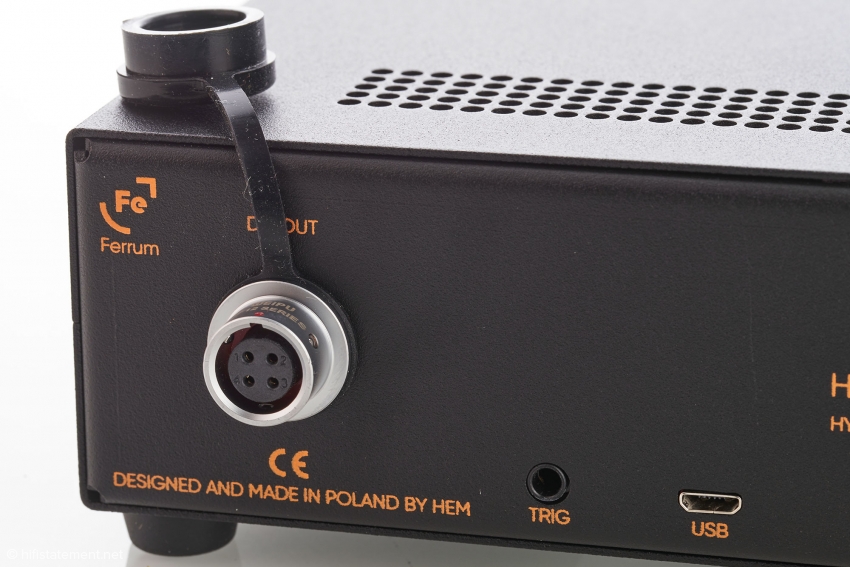
DC output, IEC socket, trigger input and USB port for firmware update: nothing more is needed on the back of the unit While drummer Manu Katché kept himself rather in the background in Peter Gabriel's composition, in his solo work Neighborhoodhe can become more prominent - as to be expected, nevertheless very sensitive and serving the piece.
The opener "November 99" offers more unadulterated sounds and gives me the opportunity to examine the HYPSOS a little more intensively.
Moreover, the album fits thematically into this test, because three of the musicians on this album come from the Polish jazz scene.
Already the piano intro reveals a greater brilliance of the overtones.
The sounds seem more floating, more detached, simply more realistic and believable.
By the way, there is also a Marcin at work on the keys.
The cymbals used for ornamentation sound more spacious and assert themselves even more.
Manu Katché's special style and very individual playing dynamics are unmistakable: very supple, often almost as if in slow motion, but with a constantly present focus and clear accentuation, which discharges powerfully in the flow of the playing.
How tastefully and sensitively, but equally emphatically and determinedly the power supply and DAC make the microcosm of the smallest dynamic explosions in drumming come alive is a blessing. The drum set literally breathes. And that's not all, after all, the piece has other fantastically played instruments to offer.
At the beginning, the low-pitched bass drum and the double bass caress each other; later, with the main motif of the piece, the double bass clearly sets itself apart from the rest of the musical action. The playing dynamics of the bassist Sławomir Kurkiewicz are just as effortlessly comprehensible as those of the drummer before.
The low bass of the double bass seems to merge even better with the overtones, which is very good for the organic component of the instrument.
Switching off the 4T sensing in no way serves to turn the sound signature of the HYPSOS upside down.
Although the sound image seems minimally more relaxed and the detail resolution is somewhat scaled back, a high level of detail still remains the sound core of the PSU.
A rather smooth and earthy sound will not be achieved with the HYPSOS. Switching off the spectrum mode does not result in any significant sound differences in my system. A rather smooth and earthy sound will not be achieved with the HYPSOS. Switching off the spectrum mode does not result in any significant sound differences in my system.
A rather smooth and earthy sound will not be achieved with the HYPSOS. Switching off the spectrum mode does not result in any significant sound differences in my system.
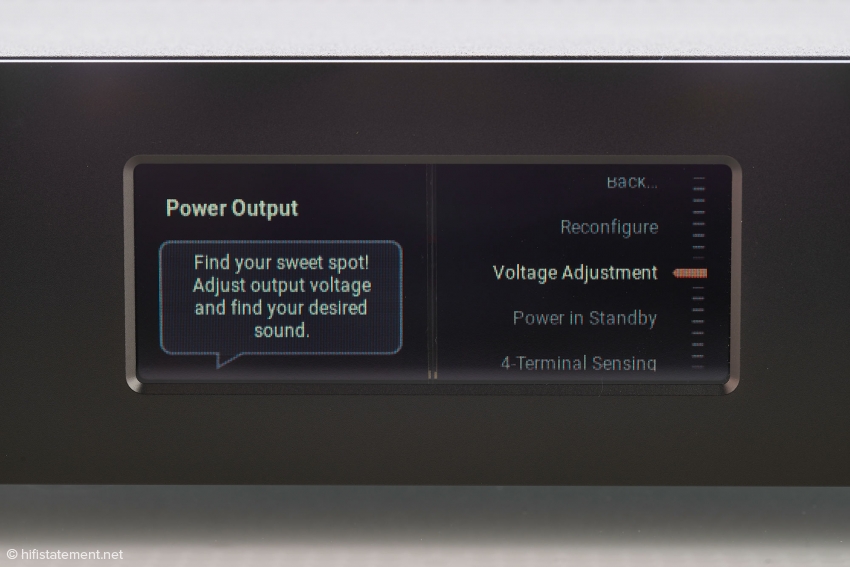
For those who like to experiment, the connected devices can be supplied with slightly more or less voltage to find the sonic optimumwhich is now powered by a linear power supply. In this configuration, Patrice Heral's 'Improvisation' from Michel Godard's albumLe Concert Des Parfums , for example, sounds a little less thrilling than usual.
Also, I'm sure I've been spoiled by a touch more bass pressure before.
But if I really want to treat myself to the highest level of musical enjoyment, the M-Scaler is not powered by its mains adapter but by battery packs: the upsampler reacts quite sensitively to its power supply.
This is immediately confirmed when the HYPSOS delivers around 13 watts to the M-Scaler: The soundstage now seems much wider and deeper. In terms of dynamics, emotionality and punch in the low frequency range, no wishes remain unfulfilled.
Thanks to the rumbling timpani in a large space and a shakuhachi - a Japanese bamboo flute - even "Raijin" from Arild Andersen's album Mirabecomes a musical and sonic delight.
This does not change when one of the Poweradds instead of the HYPSOS power the M-Scaler from rechargeable batteries: The probably imaginary soundstage retains its impressive dimensions, the fine resolution is at least as good as with the Ferrum, which, however, has a little more to offer in terms of dynamics than the battery pack.
From now on, I don't need to worry about charged power packs.
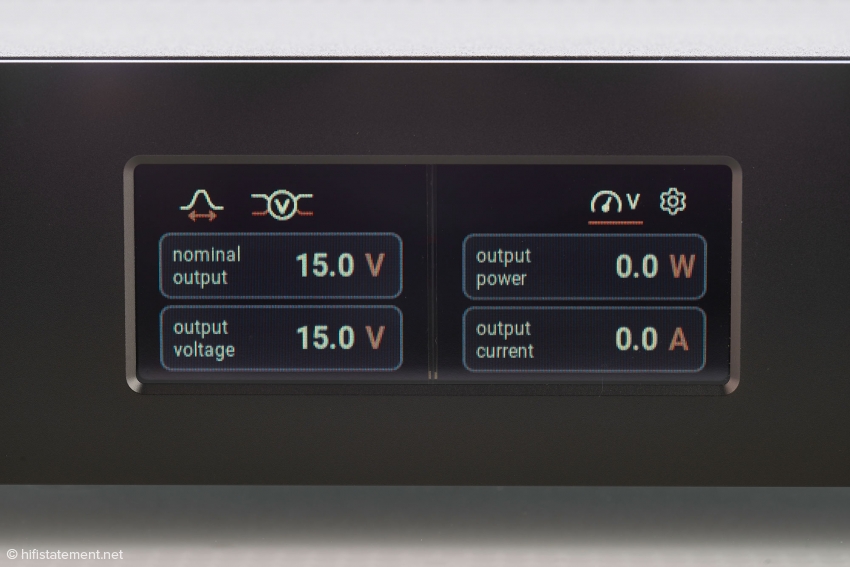
The HYPSOS provides more comfort and also a touch more pressure and speed. Great!
During operation, the display provides information about the voltage and the power taken by the connected device and also the currentBefore I move the Ferrum to the system in the living room, I allow myself one more attempt that makes a mockery of any rational consideration: I exchange the SBooster power supply, which feeds one of the two 10Gtec media converters for the fiber optic connection to the router, for the HYPSOS.
The SBooster is already grossly disproportionate to the price of the converter - we're talking about a factor of ten here - and yet it made a decidedly positive impact in terms of sound.
Unfortunately, it's the same with the Ferrum: it's several times more expensive than the SBooster and yet provides a more solid bass foundation, a more intense groove and more air around the instruments. But now to a more suitable playing partner for the HYPSOS, the Auralic Aries Femto, which receives the music files in the living room via WLAN and forwards them to the Mytek Manhattan II for conversion. Some years ago even the high-quality power supply unit in a metal housing that was supplied with the Femto didn't stand a chance against a first-generation SBooster power supply unit in terms of sound quality. In the meantime, the Femto receives its power from an SBooster MKII.
Here, too, the HYPSOS does what one can expect for three times the price of the SBooster: it raises the spatial presentation, the richness of timbre, the energy flow - especially in the bass - and the rhythmic precision to a significantly higher level. Neither with the M-Scaler nor with the media converter were the improvements through the Ferrum HYPSOS as serious as here: I know of no better external power supply. Of course, this quality has its price. But for that, the Hypsos is also universally applicable!
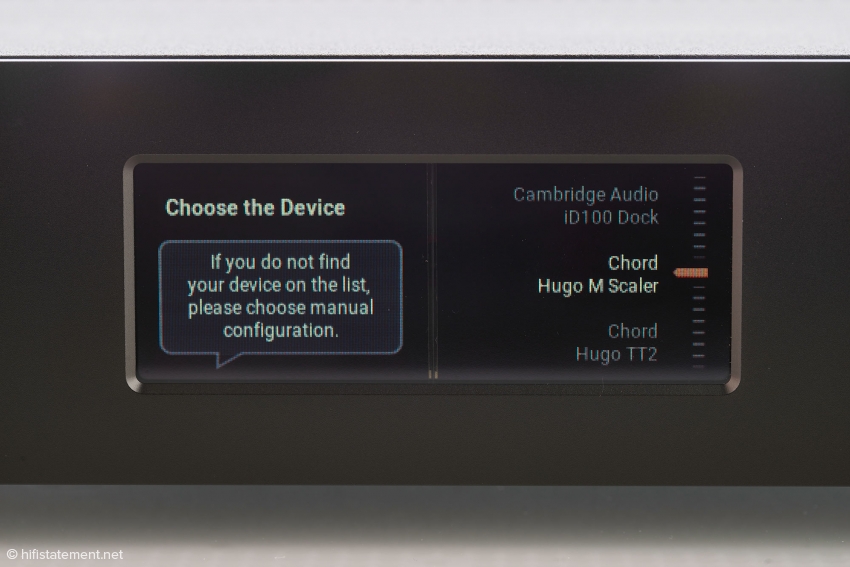
The list of pre-configured devices can be constantly expanded via firmware update
Finally, I would like to compare the HYPSOS with the other active power supplies in my chain.
Each of the different power supplies has an individual characteristic: the Keces P3, for example, sounds very dynamic and, like the HYPSOS, very lively. In direct comparison to the SBooster of the first generation, however, a little fluttering.
The SBooster power supply sounds more grounded, more stable. Conversely, however, one could say that the SBooster PSU sounds a little bit boring.
But perhaps a certain calmness of playback is exactly what the stereo system in question lacks. So often the choice of power supply is a question of point of view and personal taste. Which variant do you find more suitable and which power supply harmonises better with the intended device?
For my taste and the Brooklyn DAC +, the point clearly goes to the HYPSOS.
It offers both a solid foundation of reproduction and an impressive detail that I had never experienced before. In view of its significantly higher price, however, this additional performance in no way means a devaluation of the other two power supplies in my system. Admittedly, the comparison with a completely new type of power supply is not entirely fair.
Furthermore, as far as I know, there is currently no real competitor for the Ferrum HYPSOS with similar technology.
The flexibility of this power supply is unparalleled. Once again, it offers every conceivable voltage between five and 30 volts, accurate to a tenth of a volt, with up to 80 watts output power.
This makes it a no-brainer for listeners who like to try out different devices or use frequently changing devices in their chain.
You almost always have a suitable, high-quality power supply unit at hand to upgrade your equipment. The 4T sensing design, the precise monitoring and stabilization of the voltage at the device via the four-core supply cable, is also a feature that should not be neglected.
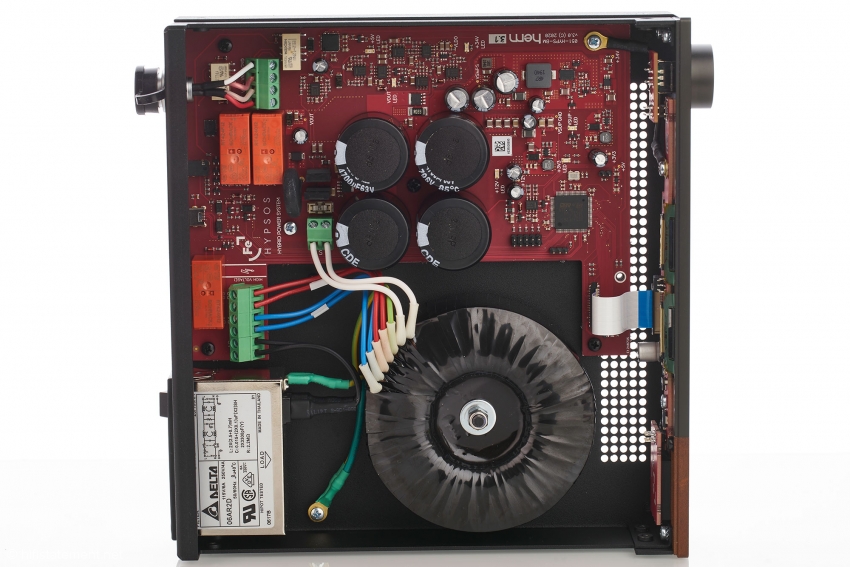
Ferrum's first step to the hifi market is not only a success, but also an incredibly good advertisement for the new brandHybrid power supply or not, the toroidal transformer and electrolytic capacitors are very well dimensioned
STATEMENT
The Ferrum HYPSOS impressively establishes a new power supply category: powerful and flexible to use on a variety of devices with features that leave room for experimentation.
It helps my Brooklyn DAC + to operate on a new musical level.
The focus is on a previously unattainable level of detail, liveliness and dynamics.
At the same time, the power supply is a real gem and first-class workmanship.
It may sound like an empty phrase, but for me it is clear: I need a HYPSOS. I have already placed a corresponding order at HEM.
Thank HIFISTATMENT for a Great Review
https://www.hifistatement.net/
Πληροφοριες και Τιμες εδω

